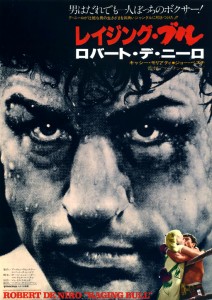Raging Bull (1980) Review
Director: Martin Scorsese
Producers: Robert Chartoff and Irwin Winkler
Cast: Robert de Niro, Martin Scorsese, Joe Pesci, Cathy Moriarty, Frank Vincent, Theresa Saldana, Nicholas Colasanto, Charles Scorsese, Frank Adonis
Running Time: 129 minutes
By JJ Bona
There can be no questions or even any real discussion regarding how good a movie Raging Bull is -and it is everything you have heard it to be, and more. The contrast of documentary-drab with dreamy black and white shots framed to perfection make for classic Scorsese. The genius dimensions of character, grim and bleak to the bitter end, reducing us to a wreckage, shocked by the sheer depravity that the human spirit is capable of, is all the De Niro we know. And the chocolate velvet of Jake LaMotta’s blood, draining away like so much rainwater, is the story of a boxer we have been waiting for.
Raging Bull is about so much more than boxing! For all the words that have been written on the extraordinary recreation of LaMotta’s most famous fights, which give the movie its rhythm and beat, it is plain to see that Scorsese has no interest in prowess or strategy. In the same way that the horse racing tips NZ has to offer cannot begin to give you the thrills and spills the sport itself does, Raging Bull has a lot more to offer than just an evocation of a great boxer. Pugilism was rendered merely contextual. What brought Scorsese to this movie was the heart of darkness it explores.
The much-lauded Method acting De Niro is so famous for is very much in evidence in Raging Bull. The actor actually entered real fights in order to brush up on his boxing skills, and it took two months for him to swell up, with the Italian actor managing to do so thanks to piles of pasta and mountains of ice-cream. It is in the character’s quietest moments that De Niro’s performance reveals its mastery, allowing us to watch as the threads of self-control loosen to allow for the unavoidable rupture we dread as much as LaMotta actively seeks it.
Raging Bull was a film made during a time when the undiluted block of commercialism was thrusting aside the wide-eyed opportunism of American 1970s cinema. Scorsese witnessed the strain mounting up around him, and this goes a long way towards explaining the unusual tension between spectacle and authenticity, and art and pleasure evident in Raging Bull. As LaMotta pitifully intones in to the sordid reflection of his own face as the film limps to its inevitable ending, So gimme a stage where this bull here can rage. And though I can fight, I’d much rather recite – that’s entertainment.
Raging Bull is entertainment, to be sure, but it is also an exploration of the human condition, and, in my opinion, remains one of the finest films to ever be made. No serious movie fan can rightfully call themselves one without having given this movie at least one screening -preferably more.



